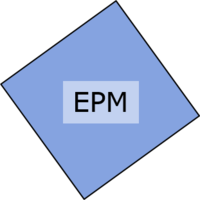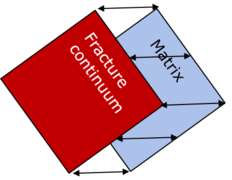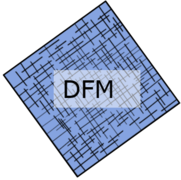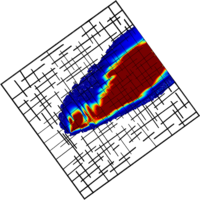Model concepts
| Highlights |
|---|
|
ContentsModel conceptsModel concepts of different complexity can be used for the modeling of flow and transport in fractured porous media. Here is an overview of some major groups. The model concepts are discussed for their applicability in the chapter Recommendations for modeling fractured limestone aquifers and comparison of model concepts. Equivalent porous-medium model (EPM)The equivalent porous medium model is a standard model concept for porous media with parameters averaged over control volumes (e.g. hydraulic conductivity, porosity). Usually, a flow model and a transport model are solved. The flow field can be computed based on Darcy's law. The contaminant transport is described by the advection-dispersion equation, where different processes like sorption and degradation can be included. Due to its simplicity and its low computational effort, the EPM model is widely used, also for fractured geologies.
Fractures, however, are not explicitly modeled.
Instead, bulk hydraulic conductivities and effective diffusion or dispersion coefficients are used.
This has as consequence that flow and transport in fractures and the exchange with the matrix cannot be correctly reproduced, leading to poor predictions for transport in dual-continuum aquifers.
Dual-continuum modelThe dual-continuum model, often also called dual-porosity model, uses two continua, the matrix and the fracture continuum.
Balance equations for flow and transport are formulated for each continuum, and the two continua have the same dimensionality (e.g. 3D fracture continuum and 3D matrix continuum).
The continua are coupled via exchange fluxes using the source and sink terms in the balance equations, allowing for exchange of water and substances between fractures and matrix.
For that purpose, exchange coefficients have to be specified, which determine the exchange fluxes between fracture and matrix continuum.
The exchange coefficients are usually used as fitting parameters.
The basic concept is described in Gerke and Van Genuchten (1993) [1].
Different parameters are used in the two continua, f.e. porosities and conductivities specific for the fractures and for the matrix.
Concepts with more than two coupled continua have also been developed, f.e. the Multiple INteracting Continua approach (MINC).
Discrete-fracture model (DFM)The discrete-fracture model (DFM) is the most detailed approach for fracture flow and transport modeling. The (major) fractures are explicitly discretized and embedded in the porous matrix. Fractures and matrix are coupled at the fracture-matrix interface by flux continuity and continuity of the primary variables (hydraulic head, concentration). This is the most physically-based approach and the exchange fluxes between fractures and matrix are calculated by the model. However, the numerical efforts are also highest for this model, especially for complex fracture networks with many fractures. For good simulation results, a very fine grid resolution at the fracture-matrix interface is essential, particularly when the contrast between fracture and matrix conductivity is strong. Usually, the fractures are resolved with one dimension less than the matrix (e.g. matrix is a 3D volume while the fractures are 2D planes). The geometric properties of the fractures have to be specified by properties like aperture, length, spacing and main orientation. The cubic law (based on the parallel-plate model) is often used to determine the fracture hydraulic conductivity based on the hydraulic aperture. In combination with Darcy's law and the hydraulic gradient, it is used to compute the flux and the velocity in fractures. The cubic law scales the fracture flux with the aperture cubed, hence large-aperture fractures contribute significantly stronger to the total flux than fractures with smaller apertures.
Random-walk methodsContinuous-time random walk methods (CTRW). |
- ↑ Gerke and Van Genuchten (1993). A Dual-Porosity Model for Simulating the Preferential Movement of Water and Solutes in Structured Porous Media, Water Resources Research, 29, 305-319.



